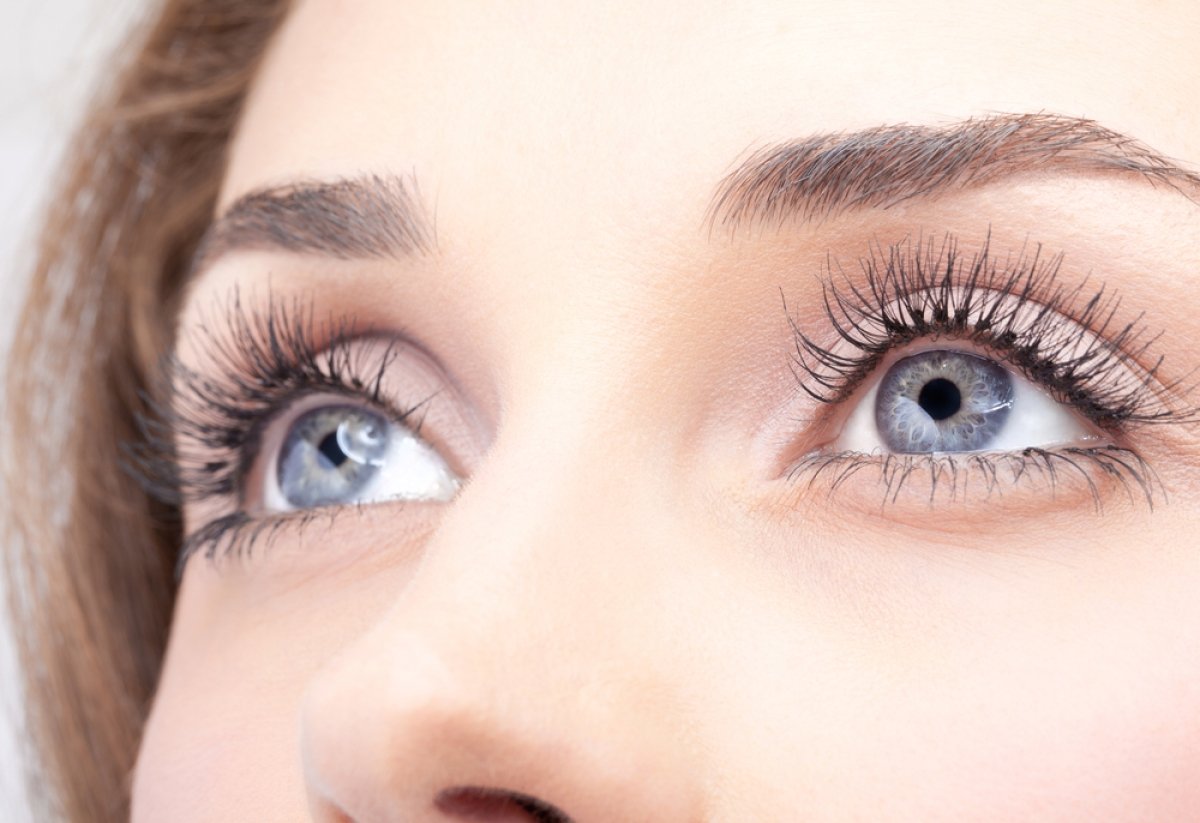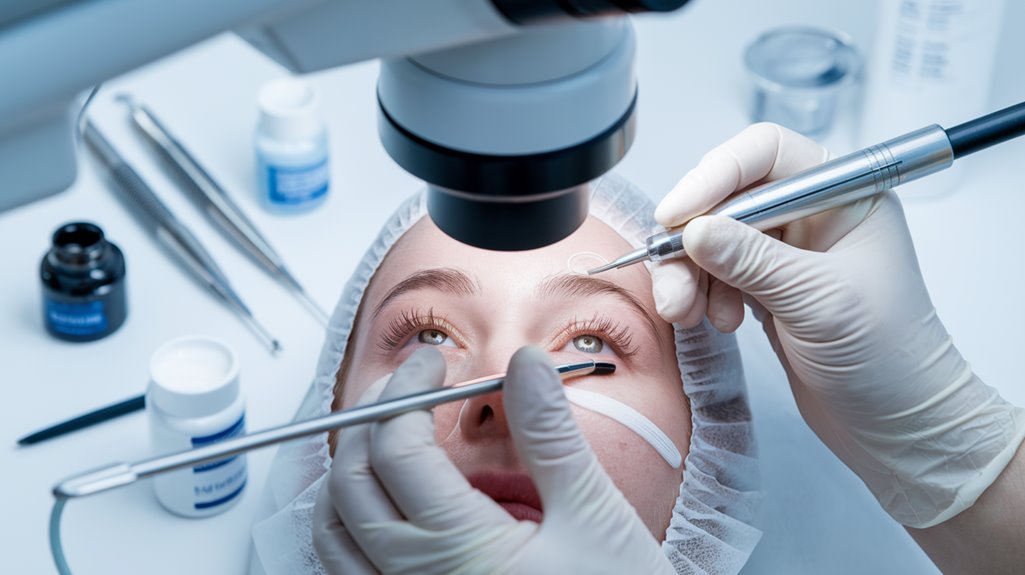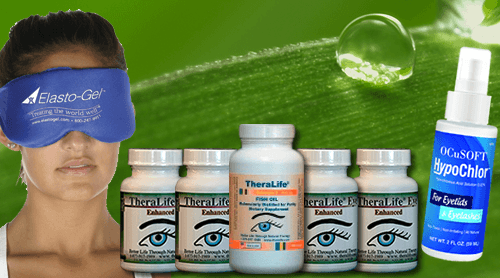To effectively address Demodex blepharitis, TheraLife.com offers a range of innovative solutions that benefit its customers through advanced eyelid hygiene products. These products contain natural ingredients like terpinen-4-ol from tea tree oil, known for its acaricidal properties, which help eliminate mite infestations. TheraLife's precision applicators ensure accurate product delivery, while their micellar technology aids in thorough cleansing. The inclusion of antiparasitic agents alongside antimicrobials helps combat resistance, providing comprehensive care.
TheraLife.com also emphasizes the importance of consistent treatment adherence, offering detailed guidance for optimal patient outcomes. In-office procedures such as laser therapy are available for more targeted interventions. Additionally, TheraLife provides an array of resources on their website, including articles on managing blepharitis, the impact of environmental factors on eye health, and the role of diet in managing dry eyes and related conditions.
Overall, TheraLife.com is dedicated to reshaping Demodex management with cutting-edge strategies, ensuring customers receive effective and natural treatment options tailored to their specific needs.
Key Takeaways
- Use advanced eyelid hygiene products with natural ingredients to effectively target Demodex mites and improve patient compliance.
- Implement precision applicators and micellar technology for uniform distribution and efficient debris removal in managing Demodex blepharitis.
- Utilize diluted tea tree oil formulations, specifically terpinen-4-ol, for treating Demodex mites without causing irritation.
- Combine antiparasitic and antimicrobial agents to enhance treatment effectiveness against Demodex blepharitis.
- Regularly monitor treatment progress and adjust strategies to ensure optimal outcomes and prevent mite reinfestation.
Understanding Demodex Mites and Their Impact
Even though they may not be visible to the naked eye, Demodex mites can greatly affect ocular health, particularly when they proliferate uncontrollably.
These microscopic parasites, primarily Demodex folliculorum and Demodex brevis, are part of the normal microflora of the eyelid margin. However, an overabundance can lead to significant eyelid health issues, including blepharitis.
Understanding mite biology is essential—Demodex mites thrive in hair follicles and sebaceous glands, feeding on sebum and epithelial cells. This can cause inflammation and discomfort, resulting in symptoms like itching, redness, and crusting. Research has shown that Demodex density is correlated with the severity of symptoms, highlighting the importance of effective treatment strategies.
The Challenges of Traditional Treatments
When treating Demodex blepharitis, you're likely aware that traditional methods often exhibit limited efficacy, leading to persistent symptoms. Additionally, these treatments may carry risks of side effects, impacting patient compliance and safety. The development of resistance further complicates these options, necessitating consideration of alternative or adjunctive therapies. A promising treatment option is TP-03 by Tarsus Pharmaceuticals, which is currently in Phase 3 trials aiming to be the first FDA-approved treatment for Demodex blepharitis.
Limited Efficacy Concerns
Addressing the challenges of traditional treatments for Demodex blepharitis, it's vital to understand their often limited efficacy. Many conventional therapies, including topical ointments and shampoos, struggle to eradicate the microscopic mites completely. These treatments often focus on symptomatic relief rather than targeting the root cause of infestation. With limited efficacy concerns, patients may not experience significant improvements, leading to persistent symptoms like itching and inflammation. Blepharitis treatment requires addressing eyelid infection, dry eyes, and clogged meibomian glands for effective management. As a result, exploring treatment alternatives becomes important. Innovations such as tea tree oil-based formulations and intense pulsed light therapy have shown promise in effectively combating Demodex mites. These alternatives highlight the need for evidence-based approaches that address the limitations of traditional methods. By prioritizing thorough solutions, you can better manage Demodex blepharitis and improve patient outcomes.
Side Effects Risks
Moving from the limited efficacy concerns, another challenge with traditional treatments for Demodex blepharitis is the risk of side effects.
You might experience potential complications such as ocular irritation, allergic reactions, or even exacerbation of symptoms. Topical medications often contain preservatives and active agents that can induce adverse reactions.
These complications may not only affect immediate comfort but also pose long term effects on ocular surface health. Chronic use of certain treatments can lead to cumulative toxicity, altering the delicate balance of the ocular microbiome and potentially worsening blepharitis.
It's essential to monitor for side effects and consult healthcare professionals to mitigate risks. Understanding these potential complications helps in making informed decisions about your treatment strategy, ensuring safety and effectiveness. Blepharitis can disrupt daily life and impact eye health significantly, making proper treatment and management critical.
Resistance Development Issues
Although traditional treatments for Demodex blepharitis can offer temporary relief, they often lead to resistance development, complicating long-term management. Resistance mechanisms arise as mites adapt to frequent exposure to conventional acaricidal agents, diminishing their efficacy. Over time, these adaptations necessitate higher doses or alternative medications, increasing the risk of adverse effects and treatment failure. It's vital to recognize that reliance on single-agent therapies may contribute to resistance issues. Exploring treatment alternatives, such as combination therapies and novel agents, is essential to circumvent these challenges. Incorporating Tea Tree Oil cleansers as part of a comprehensive treatment plan can effectively target Demodex mites without contributing to resistance, providing a holistic approach to managing blepharitis.
Innovations in Eyelid Hygiene Products
You're now witnessing a paradigm shift in eyelid hygiene with advanced cleansing formulations that effectively target Demodex mites. Incorporating natural ingredient benefits enhances therapeutic outcomes, offering anti-inflammatory and antimicrobial properties without adverse effects. Enhanced application techniques guarantee precision and efficacy, improving patient compliance and overall ocular health. Specialized eyelid cleansers such as Avenova Eyelid Cleanser are effective against bacteria, providing an essential tool in the management of blepharitis.
Advanced Cleansing Formulations
As the understanding of Demodex blepharitis progresses, advanced cleansing formulations have emerged, revolutionizing eyelid hygiene with innovative products.
These advanced formulation benefits include enhanced efficacy in eradicating Demodex mites and reducing associated symptoms. By employing targeted cleansing solutions, these formulations specifically disrupt the mites' life cycle, providing a more precise approach to treatment.
The integration of surfactants and antimicrobial agents within these products guarantees thorough sanitation of the eyelid margin, minimizing inflammation and irritation. The formulations are meticulously designed to maintain the delicate balance of the ocular surface microbiome, promoting overall ocular health while guaranteeing patient compliance.
Natural Ingredient Benefits
Building upon the advancements in cleansing formulations, exploring the benefits of natural ingredients in eyelid hygiene products offers a complementary approach to managing Demodex blepharitis.
Natural remedies, such as herbal extracts, have gained attention for their potential in reducing mite populations and alleviating symptoms. Tea tree oil, a commonly referenced extract, exhibits acaricidal properties, effectively targeting Demodex mites.
Additionally, chamomile and aloe vera extracts provide anti-inflammatory and soothing effects, easing eyelid irritation. Incorporating these ingredients into eyelid hygiene regimens can enhance therapeutic outcomes.
The integration of herbal extracts in eyelid cleansers not only addresses Demodex infestation but also promotes ocular surface health.
Emphasizing evidence-based formulations, these natural solutions offer a holistic, patient-centered strategy for effective management.
To further mitigate the impact of blepharitis, maintaining good hygiene practices is essential in preventing flare-ups and managing symptoms effectively.
Application Techniques Enhanced
Innovative application techniques in eyelid hygiene products have greatly enhanced the management of Demodex blepharitis. By improving the delivery and penetration of active ingredients, these techniques guarantee enhanced effectiveness against mite infestations.
You'll find that precision applicators, for instance, allow for targeted treatment, minimizing wastage and maximizing therapeutic impact. Furthermore, pre-soaked pads guarantee uniform distribution of the cleansing solution, providing consistent efficacy.
Incorporating micellar technology facilitates gentle yet efficient removal of debris and mites without irritating your eyelids. Additionally, time-release formulations steadily deliver active agents, offering prolonged protection throughout the day.
A new approach involves using pure hypochlorous acid, which is naturally produced by the body, to enhance the cleansing process and promote overall eye health.
- Precision applicators guarantee targeted treatment.
- Pre-soaked pads provide consistent efficacy.
- Micellar technology achieves gentle and effective cleansing.
- Time-release formulations offer prolonged protection.
These innovations in application techniques have certainly revolutionized eyelid hygiene, combating Demodex blepharitis more effectively.
The Role of Tea Tree Oil in Mite Control
Despite ongoing research, the role of tea tree oil in controlling Demodex mites remains a topic of debate among experts. Clinical studies have shown variable efficacy, but many practitioners still recommend its use for mite control. Tea tree oil's active component, terpinen-4-ol, is believed to disrupt the mites' cellular structure. It is important to note that Demodex mites are involved in approximately 30% of chronic blepharitis cases. Incorporating tea tree oil into your regimen may involve diluted formulations to avoid irritation. It's essential to monitor for any adverse reactions and consult with an ophthalmologist for tailored advice. While tea tree oil offers promise, its precise role in Demodex management requires further investigation.
| Component | Function |
|---|---|
| Terpinen-4-ol | Disrupts cellular structure |
| Cineole | Antimicrobial properties |
| Limonene | Enhances absorption |
| Alpha-terpineol | Potential anti-inflammatory |
| Sesquiterpenes | Contributes to aroma |
Antimicrobial and Antiparasitic Agents
When addressing Demodex blepharitis, understanding the role of antimicrobial and antiparasitic agents is crucial. These agents are vital in managing mite infestations efficiently. Antiparasitic efficacy targets Demodex mites directly, reducing their population on the eyelids.
However, antimicrobial resistance poses a challenge, as improper use can lead to reduced treatment effectiveness. You should consider evidence-based strategies when selecting these agents to guarantee ideal outcomes. Incorporating these agents as part of a thorough management plan can greatly alleviate symptoms and prevent recurrence.
- Targeted therapy: Focuses on reducing mite populations while minimizing resistance risks.
- Combined treatments: Using both antimicrobial and antiparasitic agents can enhance effectiveness.
- Patient compliance: Guarantees consistent application and adherence to regimens.
- Regular monitoring: Assesses treatment progress and adjusts strategies accordingly.
Advances in In-Office Procedures
As advancements in medical technology continue to evolve, in-office procedures for managing Demodex blepharitis have become increasingly refined and effective. These procedures offer targeted interventions to alleviate symptoms and reduce mite populations. Laser therapy is a notable option, providing precision in targeting affected areas. This modality uses light to eradicate Demodex mites, thereby reducing inflammation and improving eyelid hygiene. On the other hand, cryotherapy options involve the application of extreme cold to eliminate mites, proving effective in mitigating infestation.
| Procedure | Benefits |
|---|---|
| Laser Therapy | Precise targeting, reduces inflammation |
| Cryotherapy | Effective mite elimination, alleviates symptoms |
Both procedures are bolstered by clinical evidence, ensuring you benefit from cutting-edge solutions tailored to your specific needs.
The Importance of Consistent Treatment Regimens
Establishing a consistent treatment regimen is essential in managing Demodex blepharitis effectively. Adherence to prescribed treatments guarantees the eradication of mites and alleviates symptoms.
Educating patients about the chronic nature of blepharitis and the necessity for ongoing management is vital. You need to understand that commitment to treatment adherence can greatly impact the success rate of interventions.
- Consistency: Regular application of prescribed treatments enhances effectiveness.
- Patient Education: Understanding the disease process improves compliance.
- Monitoring: Regular follow-ups help track progress and adjust treatments.
- Long-term Strategy: Emphasize the importance of maintenance therapy to prevent reinfestation.
Integrating Technology in Mite Management
Technological advancements in mite management offer innovative approaches to enhance the effectiveness of treatment regimens for Demodex blepharitis.
You can now leverage smart devices and mobile apps to monitor and manage this condition more effectively. Smart devices equipped with high-resolution imaging can help in precise identification of mite infestations, allowing for tailored interventions.
Mobile apps provide platforms for tracking symptoms, adherence to treatment protocols, and reminders for medication schedules. These tools contribute to personalized treatment plans, improving compliance and outcomes.
Real-time data collection through these technologies facilitates evidence-based adjustments to therapy, optimizing patient care.
Future Directions in Demodex Blepharitis Treatment
While advancements continue to shape the landscape of Demodex blepharitis treatment, future directions focus on innovative therapies and refined diagnostic techniques.
As future research explores the genetic makeup and behavior of Demodex mites, a more targeted approach to treatment becomes possible. Emerging treatment guidelines are expected to emphasize precision medicine, employing tailored therapies based on individual patient profiles.
Furthermore, advanced imaging technologies will likely enhance diagnostic accuracy, enabling earlier intervention.
- Genomic studies: Unraveling mite DNA to identify vulnerabilities.
- Precision medicine: Customizing treatments to patient-specific genetic markers.
- Advanced imaging: Utilizing high-resolution techniques for early detection.
- Interdisciplinary collaboration: Integrating insights from dermatology, ophthalmology, and microbiology.
These future directions promise to refine therapeutic strategies, ensuring more effective management of Demodex blepharitis.
Frequently Asked Questions
What Are the Early Signs of Demodex Blepharitis?
You should watch for early signs of demodex blepharitis, such as eyelid irritation and eyelash loss.
Patients often experience itching, redness, and a gritty sensation in the eyes.
This condition is characterized by cylindrical dandruff at the base of the eyelashes.
You may notice eyelid margins becoming inflamed due to mite infestation.
Eyelash loss occurs as mites disrupt follicular integrity, emphasizing the need for precise diagnosis and targeted treatment.
Can Lifestyle Changes Help Prevent Demodex Infestations?
Yes, lifestyle changes can indeed help prevent Demodex infestations.
Prioritize meticulous hygiene practices by regularly cleaning eyelids with specialized cleansers. This reduces mite populations.
Additionally, stress management is vital, as stress can compromise immune function, facilitating mite proliferation.
Incorporating a balanced diet and adequate sleep strengthens your body's defenses.
Adopting these evidence-based strategies decreases the likelihood of infestations, promoting ocular health and alleviating Demodex-related complications.
Are There Any Natural Remedies Effective Against Demodex Mites?
Imagine your skin as a battleground, where tea tree oil, a potent warrior, stands ready to combat Demodex mites.
You'll find that essential oils, particularly tea tree, possess acaricidal properties that effectively reduce mite populations.
Clinical studies have demonstrated their efficacy, showing significant reductions in mite counts.
How Does Diet Influence Demodex Mite Proliferation?
You're wondering how diet influences Demodex mite proliferation. Maintaining a nutritional balance is essential.
Consuming a diet rich in omega-3 fatty acids, antioxidants, and vitamins can strengthen your immune response, potentially reducing mite infestation.
Conversely, a high-sugar, high-fat diet may exacerbate mite proliferation by promoting inflammation and compromising skin integrity.
Evidence-based studies suggest that dietary impacts are significant, as they can either hinder or facilitate mite survival and reproduction.
Can Demodex Mites Spread to Other Parts of the Body?
Imagine demodex mites as tiny explorers. Yes, they can spread to other body parts.
Demodex transmission occurs when mite behavior includes migration from their usual habitat, like eyelashes and facial skin, to other sebaceous gland-rich areas.
Studies show these mites thrive in areas with abundant sebum, such as the scalp, chest, and back.
Understanding their behavior helps in managing and preventing further infestation effectively, ensuring your skin stays mite-free.
Conclusion
Theralife.com offers a comprehensive range of products that effectively benefit customers dealing with Demodex blepharitis and other eye-related conditions. By leveraging advanced eyelid hygiene products, including those infused with the potent power of tea tree oil, Theralife provides solutions that efficiently combat eyelash mites. Their products are supported by antimicrobial agents and innovative in-office procedures, enhancing the effectiveness of treatment. Consistency is emphasized, encouraging customers to integrate these technologies and adhere to treatment regimens for optimal results. Imagine a future where Demodex infestations are easily managed, ensuring your eyes remain healthy and irritation-free. With Theralife's cutting-edge offerings, managing eye health becomes a seamless experience.




